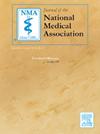对 2020-2023 年按种族/族裔和专业分列的住院医师进行横截面分析。
IF 2.5
4区 医学
Q1 MEDICINE, GENERAL & INTERNAL
引用次数: 0
摘要
背景:与美国总人口相比,少数族裔在医学教育的各个领域都代表性不足,少数族裔医生更有可能在贫困地区和初级医疗机构执业。许多个人和结构性因素造成了这种差异。我们的目的是展示不同住院医师专业的住院医师种族/族裔代表性有何不同:我们使用了美国医学院协会《住院医师报告》数据系列中的公开数据,并对 2019-2020 年至 2022-2023 年四个学年的数据进行了平均。然后,我们计算了三十四个专业中自我报告的种族/民族(单独和组合)的几率比(OR):在四年的研究期间,平均有 147026 名不重复的住院医师学员。按自我认定的种族类别(单独和组合)分列的重复住院医师平均人数包括美国印第安人或阿拉斯加原住民(839,0.6%)、亚裔(31627,21.5%)、黑人或非裔美国人(7935,5.4%)、西班牙裔、拉丁裔或西班牙血统(10900,7.4%)、夏威夷原住民或其他太平洋岛民(296,0.2%)、白人(76289,51.9%)、其他(4879,3.3%)、未知(522,0.4%)和非美国公民(23914,16.3%)。不同种族/族裔在不同专业的代表性指数存在差异。主要发现包括:公共卫生和预防医学的黑人和非裔美国人(OR=3.7)和夏威夷原住民(OR=2.6)住院医师比例较高;家庭医学的美国原住民(OR=1.9)、夏威夷原住民(OR=1.7)、黑人(OR=1.5)和西班牙裔(OR=1.3)住院医师比例较高。精神病学在少数民族住院医师中也有较高的代表性:本研究说明了各培训专科住院医师的相对种族代表性。少数民族在初级保健和公共卫生领域的代表性更高。这对建立一支适合为美国人口服务的医生队伍具有重要意义。本文章由计算机程序翻译,如有差异,请以英文原文为准。
A cross sectional analysis of residents by race/ethnicity and specialty from 2020-2023
Background
Minorities are underrepresented in all areas of medical education relative to the United States general population, and minority physicians are more likely to practice in disadvantaged areas and in primary care settings. Many individual and structural factors contribute to this discrepancy. We aimed to demonstrate how resident race/ethnicity representation differs across the various resident specialties.
Methods
We used publically available data from the Association of American Medical College's Report on Residents data series and averaged the four academic years from 2019 to 2020 through 2022-2023. We then calculated the odds ratio (OR) of self-reported race/ethnicity (alone and in combination) in thirty-four specialties.
Results
Across the four-year study period, there were, on average, 147026 unduplicated resident trainees. The average number of duplicated residents by self-identified ethnic category (alone and in combination) include: American Indian or Alaska Native (839, 0.6%), Asian (31627, 21.5%), Black or African American (7935, 5.4%), Hispanic, Latino, or of Spanish Origin (10900, 7.4%), Native Hawaiian or Other Pacific Islander (296, 0.2%), White (76289, 51.9%), Other (4879, 3.3%), Unknown (522, 0.4%), and Non-US Citizens (23914, 16.3%). Across race/ethnicity, there are differences in ORs of representation in different specialties. Key findings include high representation in Public Health and Preventative Medicine by Black and African American (OR=3.7) and Native Hawaiian (OR=2.6) residents, and Family Medicine in Native Americans (OR=1.9), Native Hawaiian (OR=1.7), Black (OR=1.5), and Hispanic (OR=1.3) residents. Psychiatry also had high ORs of representation in minority residents.
Conclusion
This study illustrates relative resident ethnic representation across training specialties. Minorities ethnicities were more likely to be represented in primary care and public health domains. This has implications for creating a physician workforce suitable to serve the United States Population.
求助全文
通过发布文献求助,成功后即可免费获取论文全文。
去求助
来源期刊
CiteScore
4.80
自引率
3.00%
发文量
139
审稿时长
98 days
期刊介绍:
Journal of the National Medical Association, the official journal of the National Medical Association, is a peer-reviewed publication whose purpose is to address medical care disparities of persons of African descent.
The Journal of the National Medical Association is focused on specialized clinical research activities related to the health problems of African Americans and other minority groups. Special emphasis is placed on the application of medical science to improve the healthcare of underserved populations both in the United States and abroad. The Journal has the following objectives: (1) to expand the base of original peer-reviewed literature and the quality of that research on the topic of minority health; (2) to provide greater dissemination of this research; (3) to offer appropriate and timely recognition of the significant contributions of physicians who serve these populations; and (4) to promote engagement by member and non-member physicians in the overall goals and objectives of the National Medical Association.

 求助内容:
求助内容: 应助结果提醒方式:
应助结果提醒方式:


